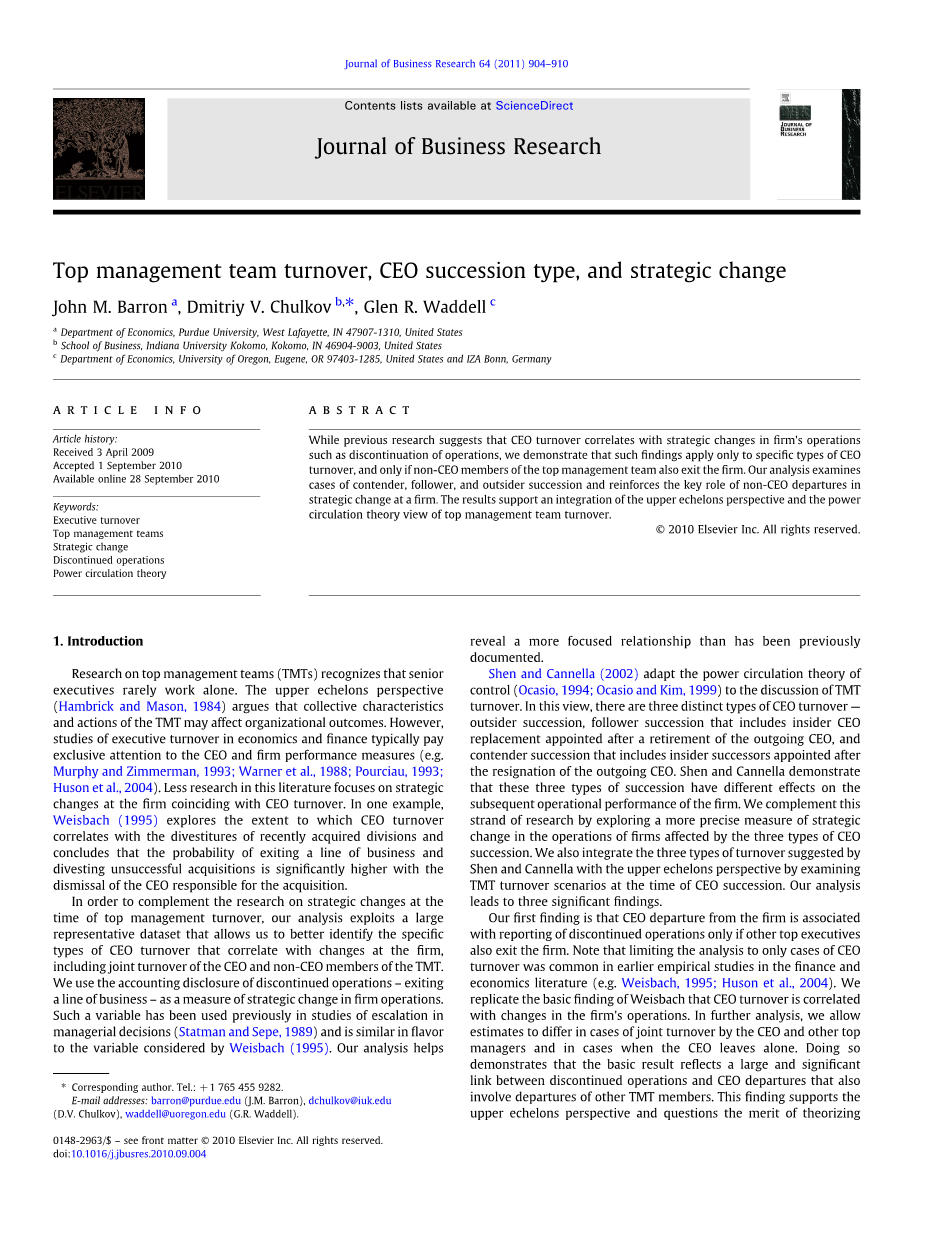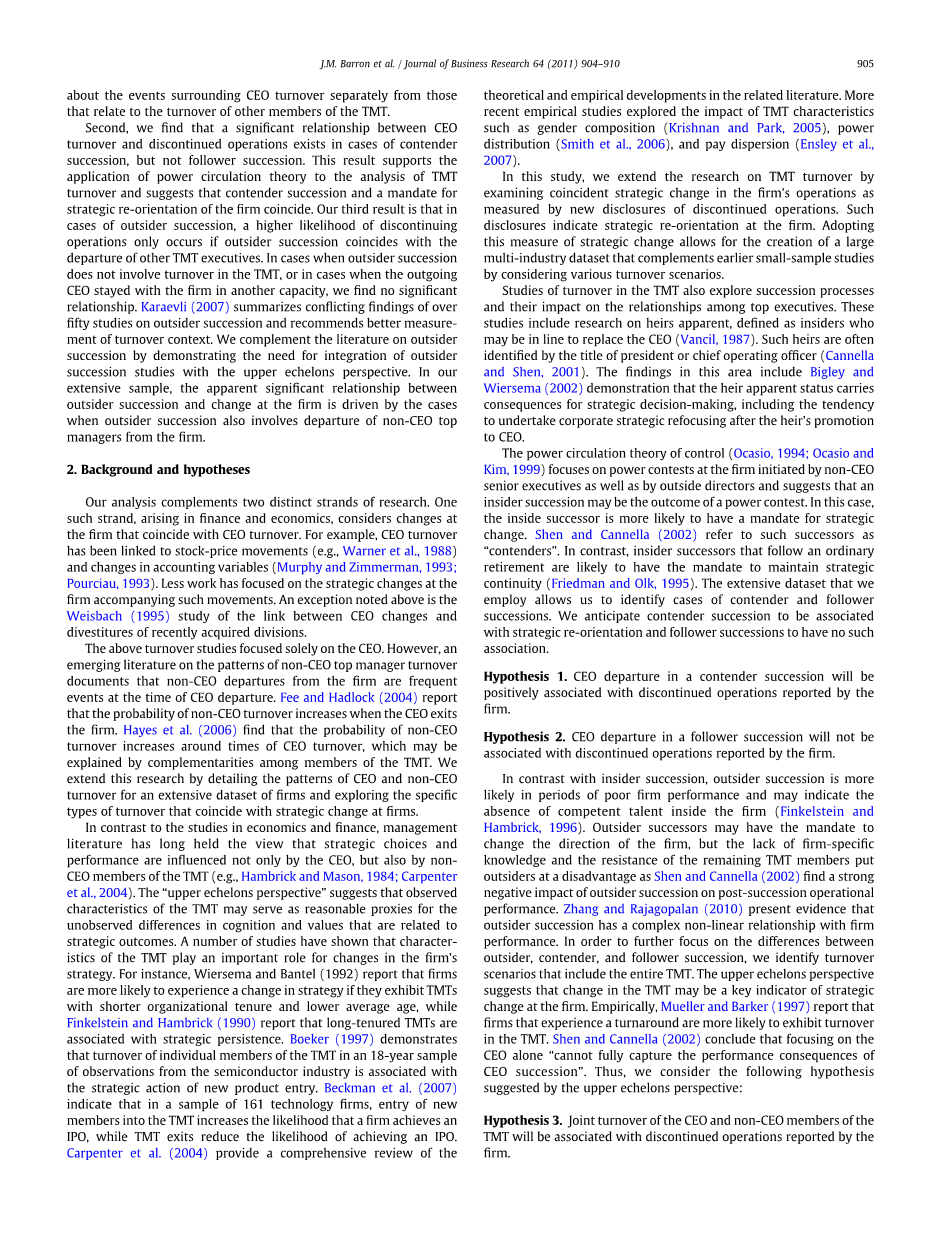

英语原文共 7 页,剩余内容已隐藏,支付完成后下载完整资料
Authors:John M.Barron,Dmitriy V.Chulkov,Glen R.Waddell一乙,C
Top management team turnover, CEO succession type, and strategic change
Journal of Business Research 64 (2011) 904–910
高层管理团队更替、CEO继任类型和战略变革
Keywords: Executive turnover, Top management teams, Strategic change, Discontinued operations, Power circulation theory
关键词:高管人员流动 最高管理团队 战略变革 停止运营 权力循环理论
Abstract:While previous research suggests that CEO turnover correlates with strategic changes in firm#39;s operations such as discontinuation of operations, we demonstrate that such findings apply only to specific types of CEO turnover, and only if non-CEO members of the top management team also exit the firm. Our analysis examines cases of contender, follower, and outsider succession and reinforces the key role of non-CEO departures in strategic change at a firm. The results support an integration of the upper echelons perspective and the power circulation theory view of top management team turnover.
摘要:虽然之前的研究表明,CEO的离职与公司运营中的战略变化(如运营中断)相关,但我们证明,这些发现仅适用于特定类型的CEO离职,并且仅当高层管理团队的非CEO成员也退出公司时。我们的分析研究了竞争者、追随者和外部继承者的案例,并强化了非CEO离职在企业战略变革中的关键作用。研究结果支持了高层管理人员流动视角和权力循环理论视角的整合。
1. 介绍
Research on top management teams (TMTs) recognizes that senior executives rarely work alone. The upper echelons perspective (Hambrick and Mason, 1984) argues that collective characteristics and actions of the TMT may affect organizational outcomes. However, studies of executive turnover in economics and finance typically pay exclusive attention to the CEO and firm performance measures (e.g. Murphy and Zimmerman, 1993; Warner et al., 1988; Pourciau, 1993; Huson et al., 2004). Less research in this literature focuses on strategic changes at the firm coinciding with CEO turnover. In one example, Weisbach (1995) explores the extent to which CEO turnover correlates with the divestitures of recently acquired divisions and concludes that the probability of exiting a line of business and divesting unsuccessful acquisitions is significantly higher with the dismissal of the CEO responsible for the acquisition.
In order to complement the research on strategic changes at the time of top management turnover, our analysis exploits a large representative dataset that allows us to better identify the specific types of CEO turnover that correlate with changes at the firm, including joint turnover of the CEO and non-CEO members of the TMT. We use the accounting disclosure of discontinued operations – exiting a line of business – as a measure of strategic change in firm operations. Such a variable has been used previously in studies of escalation in managerial decisions (Statman and Sepe, 1989) and is similar in flavor to the variable considered by Weisbach (1995). Our analysis helps reveal a more focused relationship than has been previously documented.
对高层管理团队(TMT)的研究发现,高层管理人员很少单独工作。高层观点(Hambrick和Mason,1984年)认为,高层管理团队的集体特征和行动可能会影响组织成果。然而,对经济和金融领域的高管人员更替的研究通常只关注CEO和公司绩效指标(如Murphy和Zimmerman,1993年;Warner等人,1988年;Pourciau,1993年;Huson等人,2004年)。本文献中的研究较少集中在与CEO离职同时发生的公司战略变革上。在一个例子中,Weisbach(1995)探讨了CEO离职与最近收购部门剥离的关联程度,并得出结论:随着负责收购的CEO被解雇,退出业务线和剥离不成功收购的可能性明显更高。
为了补充对高层管理人员离职时战略变化的研究,我们的分析利用了一个大型的代表性数据集,使我们能够更好地确定与公司变化相关的CEO离职的具体类型,包括CEO和TMT非CEO成员的联合离职。我们使用非连续性经营的会计披露(退出业务线)作为企业经营战略变化的衡量标准。这一变量以前曾被用于管理决策的升级研究(Statman和Sepe,1989年),在风格上与Weisbach(1995年)所考虑的变量相似。我们的分析有助于展现出一种比之前记录的更加专注的关系。
Shen and Cannella (2002) adapt the power circulation theory of control (Ocasio, 1994; Ocasio and Kim, 1999) to the discussion of TMT turnover. In this view, there are three distinct types of CEO turnover — outsider succession, follower succession that includes insider CEO replacement appointed after a retirement of the outgoing CEO, and contender succession that includes insider successors appointed after the resignation of the outgoing CEO. Shen and Cannella demonstrate that these three types of succession have different effects on the subsequent operational performance of the firm. We complement this strand of research by exploring a more precise measure of strategic change in the operations of firms affected by the three types of CEO succession. We also integrate the three types of turnover suggested by Shen and Cannella with the upper echelons perspective by examining TMT turnover scenarios at the time of CEO succession. Our analysis leads to three significant findings.
Our first finding is that CEO departure from the firm is associated with reporting of discontinued operations only if other top executives also exit the firm. Note that limiting the analysis to only cases of CEO turnover was common in earlier empirical studies in the finance and economics literature (e.g. Weisbach, 1995; Huson et al., 2004). We replicate the basic finding of Weisbach that CEO turnover is correlated with changes in the firm#39;s operations. In further analysis, we allow estimates to differ in cases of joint turnover by the CEO and other top managers and in cases when the CEO leaves alone. Doing so demonstrates that the basic result reflects a large and significant link between discontinued operations and CEO departures that also involve departures of other TMT members. This finding supports the upper echelons perspective and questions the merit of theorizing about the events surrounding CEO turnover separately from those that relate to the turnover of other members of the TMT.
Shen和Cannella(2002)将功率循环控制理论(Ocasio,1994年;Ocasio和Kim,1999年)用于讨论TMT周转。从这一观点来看,首席执行官离职有三种不同的类型:外部继承人、跟随者继承人,包括离职首席执行官退休后任命的内部首席执行官替换人,以及竞争者继承人,包括离职首席执行官辞职后任命的内部继承人。沈和Cannella证明,这三种类型的继承对公司的后续经营绩效有不同的影响。我们通过探索更精确的衡量受三种CEO接班人影响的公司运营中的战略变化来补充这一研究。我们还通过检查CEO继任时的TMT离职情况,将沈和Cannella提出的三种类型的离职与高层观点相结合。我们的分析得出了三个重要结论。
我们的第一个发现是,只有当其他高级管理人员也退出公司时,CEO离开公司才与报告中断的业务有关。请注意,在早期的金融和经济文献的实证研究中(例如,Weisbach,1995年;Huson等人,2004年),只对CEO离职的案例进行分析是很常见的。我们复制了韦斯巴赫的基本发现,CEO的离职率与公司运营的变化相关。在进一步的分析中,我们允许CEO和其他高级管理人员的联合营业额以及CEO单独离职时的估计值存在差异。这样做表明,基本结果反映了中断经营和CEO离
全文共46510字,剩余内容已隐藏,支付完成后下载完整资料
资料编号:[2289]
以上是毕业论文外文翻译,课题毕业论文、任务书、文献综述、开题报告、程序设计、图纸设计等资料可联系客服协助查找。


